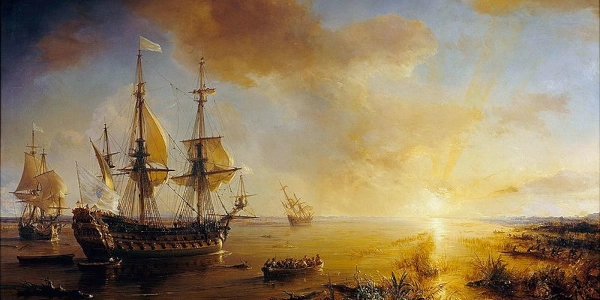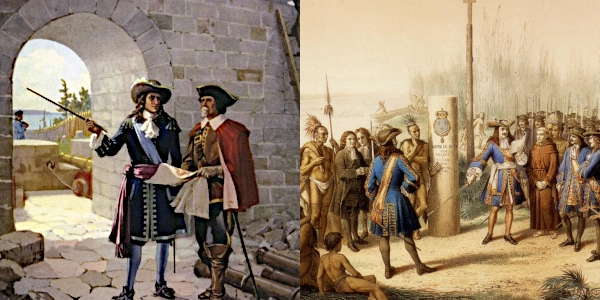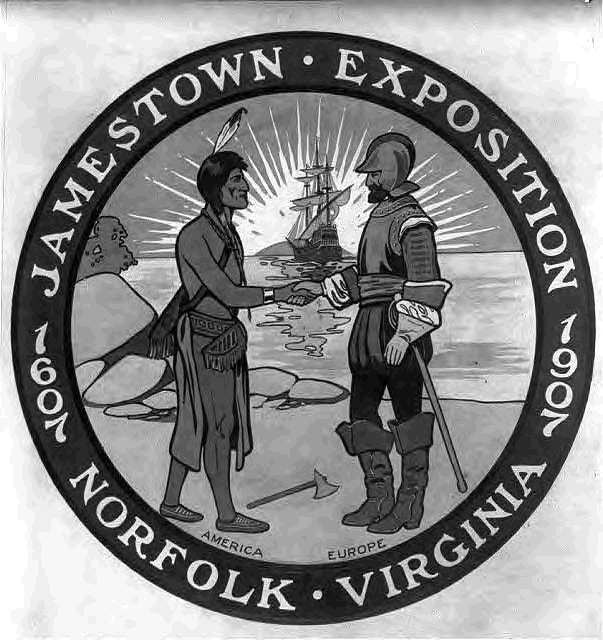Sponsor this page for $150 per year. Your banner or text ad can fill the space above.
Click here to Sponsor the page and how to reserve your ad.
-
Timeline
1684 Detail
July 24, 1684 - Robert Cavelier, Sieur de LaSalle, returns to the Americas on an expedition to establish a colony on the Gulf of Mexico, and urges additional outposts be built in Illinois and Texas to spread French influence in the central territory of North America.

He's back, this time to colonize the region along the Gulf of Mexico and up the lower Mississippi River valley found and claimed for France in 1682, despite his benefactor in Montreal no longer in power, and the fact that this journey, he had determined, should take the shorter water route from France straight to the mouth of the Mississippi River, not through the St. Lawrence, Great Lakes, then eventually down the rivers to the Louisiana colony.
Robert Cavalier de la Salle had returned to France in 1683, prepared for his trip of colonization and left July 24, 1684 for his journey with four ships; La Belle, Le Joly, L'Aimable, and one other, a Ketch. There were two hundred and eighty on board, including Henri Joutel, one hundred soldiers, young women, and workmen hired to make a settlement.
"At the Time when Monsieur de la Sale was preparing for his last Voyage into North America, I happen'd to be at Roan, the Place where he and I were both born, being return'd from the Army, where I had serv'd sixteen or seventeen Years.
The Reputation gain'd by Monsieur de la Sale, the Greatness of his Undertaking, the Natural Curiosity which all men are possess'd with, and my Acquaintance with his Kindred, and with several of the Inhabitants of that City, who were to bear him Company, easily prevail'd with me to make one of the Number, and I was admitted as a volunteer," Henri Joutel journal.
The colonists met de LaSalle at Rochel, with the four ships accompanied by twenty others bound for the islands and Canada. LaSalle and Joutel embarked on le Joly. An accident caused the four ship party to return for repairs, as the twenty others went forward to their destinations.
On August 1, 1684, they began their journey for the Mississippi River again. It was an eventful and dreadful trip; one of the ships, the unnamed fourth, a Ketch, was lost to pirates in the West Indies.
"Whilst he was in that Condition, two of our Ships, which had been separated from us on the 18th of September, by the stormy Winds, arriv'd at Petit Gouave on the 2d of October. Oct. 1684. The Joy conceiv'd on Account of their Arrival, was much allay'd by the News they brought of the Loss of the Ketch, Ketch taken by the Spaniards. taken by two Spanish Piraguas; and that Loss was the more grievous, because that Vessel was laden with Provisions, Ammunition, Utensils and proper Tools for the settling of our new Colonies; a Misfortune which would not have happen'd, had Monsieur de Beaujeu put into Port de Paix, and Messieurs de St. Laurent, de Cussy, and Begon who arrived at the same Time, to see Monsieur de la Sale did not spare to signify as much to him, and to complain of that Miscarriage," Joutel Journal.
Finally Finding America, but not the Mississippi
There had been difficulty with navigation and since no man onboard any of the three remaining ships had ever been to the Bay of Mexico or the mouth of the Mississippi from the side of the sea, they struggled to find their bearing. It has been suggested that perhaps de LaSalle had incorrectly marked them in 1862, but it is not known whether that is correct or not.
"There being no Man among us who had any Knowledge of that Bay, where we had been told the Currents were strong, and sate swiftly to the Eastward, it made us suspect that we were fallen off, and that the Land we saw must be the Bay of Apalache (Florida coast at indentation of peninsula), which oblig'd us on the 29th to steer W. N. W. still keeping along the Land, and it was agreed that the Joly should follow us in six Fathom Water," Joutel Journal.
They reached what was called the Bay of the Holy Ghost on January 10, 1685. Some think this was today's Mobile Bay. The expedition continued to travel west, but wherever they sent small boats to find the river Mississippi, it was not there. Finally, de la Salle concluded that they had passed it.
"The former of those Notions prevail'd, whence, upon Reflection, Monsieur de la Sale concluded, that he must be past his River, They pass the Mouth of the Missisipi. which was but too true; for that River emptying it self in the Sea by two Channels, it follow'd that one of the Mouths fell about the Shoals we had observ'd the sixth of the Month; and the rather because those Shoals were very near the Latitude that Monsieur de la Sale had observ'd, when he came by the way of Canada to discover the Mouth of that River, as he told me several Times," Joutel Journal.

The Texas Settlement
They reached Matagorda Bay around February 20, 1685, eighty miles north of today's Corpus Christi, and an estuary to smaller rivers, the Lavaca and Colorado River.
"As we were on our Way towards the Camp of the Savages, happening to look towards the Sea, we saw the Flyboat l' Aimable under Sail, which the Savages who were with us admir'd, and Monsieur de la Sale observing it narrowly, told us, those People steer'd wrong, and were standing towards the Shoals, which made him very uneasy, but still we advanc'd. We arriv'd at the Camp of the Savages, Their Camp. which stood upon an Eminence, and consisted of about Fifty Cottages made of rush Mats, and others of dry'd Skins, and built with long Poles, bow'd round at the Top, like great Ovens, and most of the Savages sitting about, as if they were upon the Watch.
We were still advancing into the Village, when he heard a Cannon Shot, the Noise whereof struck such a Dread among the Savages, that they all fell flat upon the Ground; but Monsieur de la Sale and we were too sensible it was a Signal that our Ship was aground, which was confirm'd by seeing them furl their Sails; However we were gone too far to return; our Men must be had, and to that Purpose, we must proceed to the Hut of the Commander in Chief," Joutel Journal.
The l'Aimable was aground and sinking, some contend on purpose, and split that night, leaving rescue parties to gather as many of the provisions on the ship as possible. An unfortunate attack between some of his men and the Indians occured on March 5, 1685; they had been peaceful and helpful up until that time. Monsieur de Beaujeu, captain of one of the two remaining boats, decided to head back to France; all de LaSalle could do was send a letter along with him, explaining their misfortunes.
A fort was built from the wreck of the ship, but some men had decided to desert the ill-fated Texas colony. One hundred and eighty men remained. de la Salle went up river on forays to find if they were on route to the Mississippi. They were not. Joutel remained behind, built an oven and finished the fort. When de la Salle returned, he determined to build another fort upriver. Eventually the flagship Le Belle, their only remaining ship, ran aground in 1686, stranding the colony in what they called the Bay of St. Louis, in the vicinity of today's Victoria, Texas.
Those extra colonies and forts that he wanted to build up and down the Mississippi River did not occur through Robert Cavalier de LaSalle's efforts, although in the ensueing years he did continue to try to find the Mississippi River.
Image above: Painting, "La Salles Expedition to Louisiana in 1684," 1844, Théodore Gudin. It shows the three ships, La Belle (left), Le Joly (middle), and L'Aimable (right, run aground), at the entrance to Matagorda Bay. Courtesy Wikipedia Commons. Image below: Montage (left) LaSalle at Fort Frontenac, 1652, John David Kelley. Courtesy Library and Archives Canada via Wikipedia, and (right), Painting of LaSalle taking possession of the lower Mississippi River for France, 1870's, lithograph by Jean-Adolphe Bocquin, printed by Lemercier & Cie, Paris. Courtesy Wikipedia Commons. Info source: Canadian Museum of History; "Joutel's Historical Journal of Monsieur de La Salle's last voyage to discover the river Mississippi," 1714, Henri Joutel; Wikipedia.


Robert Cavalier de la Salle had returned to France in 1683, prepared for his trip of colonization and left July 24, 1684 for his journey with four ships; La Belle, Le Joly, L'Aimable, and one other, a Ketch. There were two hundred and eighty on board, including Henri Joutel, one hundred soldiers, young women, and workmen hired to make a settlement.
"At the Time when Monsieur de la Sale was preparing for his last Voyage into North America, I happen'd to be at Roan, the Place where he and I were both born, being return'd from the Army, where I had serv'd sixteen or seventeen Years.
The Reputation gain'd by Monsieur de la Sale, the Greatness of his Undertaking, the Natural Curiosity which all men are possess'd with, and my Acquaintance with his Kindred, and with several of the Inhabitants of that City, who were to bear him Company, easily prevail'd with me to make one of the Number, and I was admitted as a volunteer," Henri Joutel journal.
The colonists met de LaSalle at Rochel, with the four ships accompanied by twenty others bound for the islands and Canada. LaSalle and Joutel embarked on le Joly. An accident caused the four ship party to return for repairs, as the twenty others went forward to their destinations.
On August 1, 1684, they began their journey for the Mississippi River again. It was an eventful and dreadful trip; one of the ships, the unnamed fourth, a Ketch, was lost to pirates in the West Indies.
"Whilst he was in that Condition, two of our Ships, which had been separated from us on the 18th of September, by the stormy Winds, arriv'd at Petit Gouave on the 2d of October. Oct. 1684. The Joy conceiv'd on Account of their Arrival, was much allay'd by the News they brought of the Loss of the Ketch, Ketch taken by the Spaniards. taken by two Spanish Piraguas; and that Loss was the more grievous, because that Vessel was laden with Provisions, Ammunition, Utensils and proper Tools for the settling of our new Colonies; a Misfortune which would not have happen'd, had Monsieur de Beaujeu put into Port de Paix, and Messieurs de St. Laurent, de Cussy, and Begon who arrived at the same Time, to see Monsieur de la Sale did not spare to signify as much to him, and to complain of that Miscarriage," Joutel Journal.
"There being no Man among us who had any Knowledge of that Bay, where we had been told the Currents were strong, and sate swiftly to the Eastward, it made us suspect that we were fallen off, and that the Land we saw must be the Bay of Apalache (Florida coast at indentation of peninsula), which oblig'd us on the 29th to steer W. N. W. still keeping along the Land, and it was agreed that the Joly should follow us in six Fathom Water," Joutel Journal.
They reached what was called the Bay of the Holy Ghost on January 10, 1685. Some think this was today's Mobile Bay. The expedition continued to travel west, but wherever they sent small boats to find the river Mississippi, it was not there. Finally, de la Salle concluded that they had passed it.
"The former of those Notions prevail'd, whence, upon Reflection, Monsieur de la Sale concluded, that he must be past his River, They pass the Mouth of the Missisipi. which was but too true; for that River emptying it self in the Sea by two Channels, it follow'd that one of the Mouths fell about the Shoals we had observ'd the sixth of the Month; and the rather because those Shoals were very near the Latitude that Monsieur de la Sale had observ'd, when he came by the way of Canada to discover the Mouth of that River, as he told me several Times," Joutel Journal.

"As we were on our Way towards the Camp of the Savages, happening to look towards the Sea, we saw the Flyboat l' Aimable under Sail, which the Savages who were with us admir'd, and Monsieur de la Sale observing it narrowly, told us, those People steer'd wrong, and were standing towards the Shoals, which made him very uneasy, but still we advanc'd. We arriv'd at the Camp of the Savages, Their Camp. which stood upon an Eminence, and consisted of about Fifty Cottages made of rush Mats, and others of dry'd Skins, and built with long Poles, bow'd round at the Top, like great Ovens, and most of the Savages sitting about, as if they were upon the Watch.
We were still advancing into the Village, when he heard a Cannon Shot, the Noise whereof struck such a Dread among the Savages, that they all fell flat upon the Ground; but Monsieur de la Sale and we were too sensible it was a Signal that our Ship was aground, which was confirm'd by seeing them furl their Sails; However we were gone too far to return; our Men must be had, and to that Purpose, we must proceed to the Hut of the Commander in Chief," Joutel Journal.
The l'Aimable was aground and sinking, some contend on purpose, and split that night, leaving rescue parties to gather as many of the provisions on the ship as possible. An unfortunate attack between some of his men and the Indians occured on March 5, 1685; they had been peaceful and helpful up until that time. Monsieur de Beaujeu, captain of one of the two remaining boats, decided to head back to France; all de LaSalle could do was send a letter along with him, explaining their misfortunes.
A fort was built from the wreck of the ship, but some men had decided to desert the ill-fated Texas colony. One hundred and eighty men remained. de la Salle went up river on forays to find if they were on route to the Mississippi. They were not. Joutel remained behind, built an oven and finished the fort. When de la Salle returned, he determined to build another fort upriver. Eventually the flagship Le Belle, their only remaining ship, ran aground in 1686, stranding the colony in what they called the Bay of St. Louis, in the vicinity of today's Victoria, Texas.
Those extra colonies and forts that he wanted to build up and down the Mississippi River did not occur through Robert Cavalier de LaSalle's efforts, although in the ensueing years he did continue to try to find the Mississippi River.
Image above: Painting, "La Salles Expedition to Louisiana in 1684," 1844, Théodore Gudin. It shows the three ships, La Belle (left), Le Joly (middle), and L'Aimable (right, run aground), at the entrance to Matagorda Bay. Courtesy Wikipedia Commons. Image below: Montage (left) LaSalle at Fort Frontenac, 1652, John David Kelley. Courtesy Library and Archives Canada via Wikipedia, and (right), Painting of LaSalle taking possession of the lower Mississippi River for France, 1870's, lithograph by Jean-Adolphe Bocquin, printed by Lemercier & Cie, Paris. Courtesy Wikipedia Commons. Info source: Canadian Museum of History; "Joutel's Historical Journal of Monsieur de La Salle's last voyage to discover the river Mississippi," 1714, Henri Joutel; Wikipedia.






